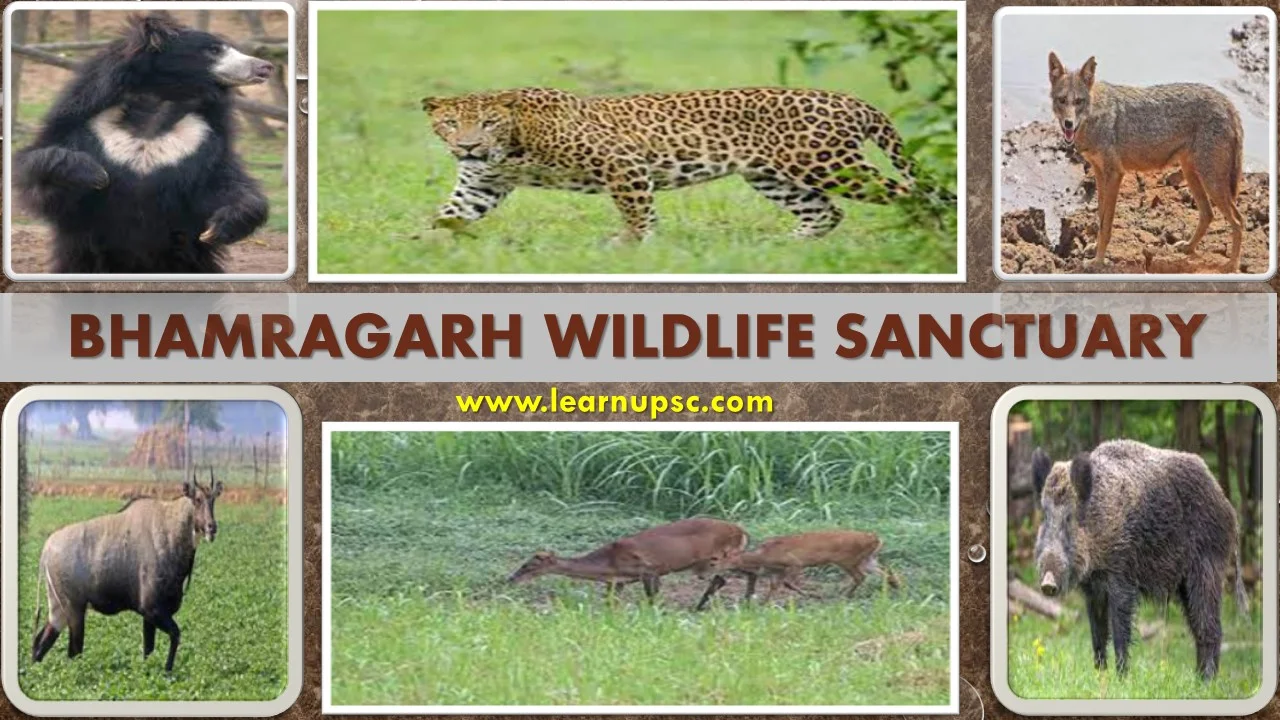Bhamragarh Wildlife Sanctuary UPSC
The Bhamragarh Wildlife Sanctuary is situated in the state of Maharashtra, India. It is diverse ecosystems, including moist deciduous mixed forests, hills, and rivers.
The sanctuary is home to various plant and animal species, contributing to its ecological significance and serving as a vital habitat for conservation efforts.
The presence of the Pamalgautam and Parlkota rivers further enhances the sanctuary's natural beauty and ecological importance.
communities, such as the Gond and Madia tribes, have historical connections to the area. The sanctuary is accessible by road and is a destination for nature enthusiasts and wildlife lovers.
|
Table of Contents
|
Bhamragarh Wildlife Sanctuary Location
Bhamragarh Wildlife Sanctuary is located in the Chandrapur District in the Vidharbha region of Maharashtra, India. It is situated in the hilly and forested terrain of the region.
Bhamragarh Wildlife Sanctuary Nearest Airport:
The nearest airport to Bhamragarh Wildlife Sanctuary is Nagpur Airport, which is located about 370 kilometers away. Travelers can use Nagpur Airport as a point of entry to reach the sanctuary.
Bhamragarh Wildlife Sanctuary Nearest Railway Station:
The nearest railway station to Bhamragarh Wildlife Sanctuary is Ballarpur Railway Station, situated at a distance of approximately 197 kilometers. This station provides a rail link to the sanctuary and the surrounding area.
Bhamragarh Wildlife Sanctuary History
Establishment and Notification: Bhamragarh Wildlife Sanctuary was officially established on May 6th, 1997, in the Chandrapur District of Maharashtra, India. The sanctuary was designated with the aim of conserving the rich biodiversity and natural habitats of the region. This move was initiated by governmental authorities in collaboration with conservation organizations.
Early History and Background: Before its establishment as a sanctuary, the region held ecological importance due to its diverse flora and fauna. The decision to create the sanctuary was influenced by the need to protect the area's unique ecosystems and prevent further habitat degradation. Indigenous communities may have had historical connections to the land.
Bhamragarh Wildlife Sanctuary Area
Bhamragarh Wildlife Sanctuary covers an area of approximately 104.38 square kilometers. The sanctuary's relatively compact size is home to a diverse range of flora and fauna, making it a vital space for the conservation of biodiversity in the region.
Bhamragarh Wildlife Sanctuary River
Bhamragarh Wildlife Sanctuary is graced by the presence of two significant rivers that flow through its expanse. The Pamalgautam and Parlkota rivers traverse the sanctuary's landscape, contributing to the sanctuary's ecological richness.
These rivers provide essential water sources for the flora and fauna within the sanctuary, fostering a diverse range of habitats and ecosystems.
Bhamragarh Wildlife Sanctuary Tribe
The Bhamragarh Wildlife Sanctuary is inhabited by various indigenous tribal communities. The Gond and Madia tribes are among the local communities that reside in the vicinity of the sanctuary. These tribes have a historical and cultural connection to the land and have traditionally relied on the forest for their habitation and livelihood.
The presence of these tribal communities adds to the sanctuary's cultural and social diversity. Efforts are often made to involve these communities in conservation initiatives and sustainable development practices to ensure that their traditional way of life harmonizes with the protection of the sanctuary's natural resources.
Bhamragarh Wildlife Sanctuary Flora
The Bhamragarh Wildlife Sanctuary is home to a diverse range of flora, which contributes to the richness of its ecosystems. The sanctuary's moist deciduous mixed forests support a variety of plant species. Here are some examples of plant species that might be found there:
- Arjun (Terminalia arjuna)
- Bija (Pterocarpus marsupium)
- Kuda (Holoptelea integrifolia)
- Bel (Aegle marmelos)
- Kusum (Schleichera oleosa)
- Mango (Mangifera indica)
- Bamboo (Bambusa spp.)
- Kadam (Anthocephalus chinensis)
- Jamun (Syzygium cumini)
- Neel (Indigofera spp.)
- Tarota (Hoplophyllum spicatum)
Bhamragarh Wildlife Sanctuary Fauna (Bhamragarh Wildlife Sanctuary Animals)
The Bhamragarh Wildlife Sanctuary is home to a diverse array of fauna, ranging from mammals to reptiles and birds. Here are some examples of the wildlife species that you might find in the sanctuary:
Mammals:
- Leopard
- Wild Boar
- Sloth Bear
- Hare
- Barking Deer
- Mongoose
- Flying Squirrel
- Bluebull
Birds:
- Junglefowl
- Peacock
Reptiles:
- Indian Cobra
- Russell’s Viper
- Indian Rock Python
- Indian Rat Snake
- Checkered Keelback
- Monitor Lizard
Bhamragarh Wildlife Sanctuary UPSC Questions
Q. In which state Bhamragarh Wildlife Sanctuary is located?
A. Bhamragarh Wildlife Sanctuary is located in the state of Maharashtra, India. It is situated within the Chandrapur District of Maharashtra. The sanctuary is known for its diverse ecosystems, hilly terrain, and rich biodiversity, making it an important conservation area within the state.
Q. What is Bhamragarh Wildlife Sanctuary famous for?
A. Bhamragarh Wildlife Sanctuary is famous for several reasons:
(i) Biodiversity: The sanctuary is renowned for its rich biodiversity, housing a diverse range of flora and fauna within its relatively compact area. Its varied ecosystems, including moist deciduous mixed forests, hills, and rivers, contribute to its ecological significance.
(ii) Wildlife: The sanctuary is home to a variety of wildlife species, including leopards, wild boars, sloth bears, deer, various bird species, reptiles like cobras and pythons, and more. This diversity of wildlife makes it an attractive destination for nature enthusiasts and wildlife photographers.
(iii) Scenic Beauty: The sanctuary's hilly terrain, rivers, and lush vegetation contribute to its scenic beauty. The natural landscapes and picturesque surroundings make it an appealing place for eco-tourism and nature exploration.
(iv) Indigenous Communities: The presence of indigenous communities, such as the Gond and Madia tribes, adds to the cultural significance of the sanctuary. The coexistence of these communities with the sanctuary's flora and fauna highlights the importance of sustainable development and community engagement.
(v) Proximity to Major Cities: The sanctuary's location in the Chandrapur District of Maharashtra makes it accessible from major cities in the state, attracting visitors who wish to experience the natural beauty and wildlife of the region.


No comments:
Post a Comment